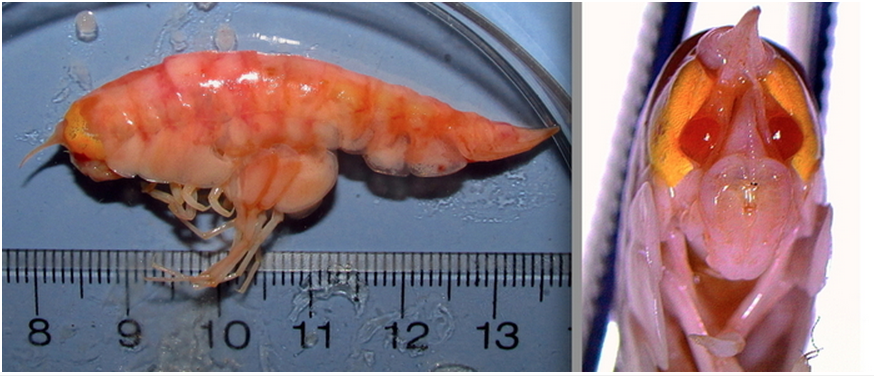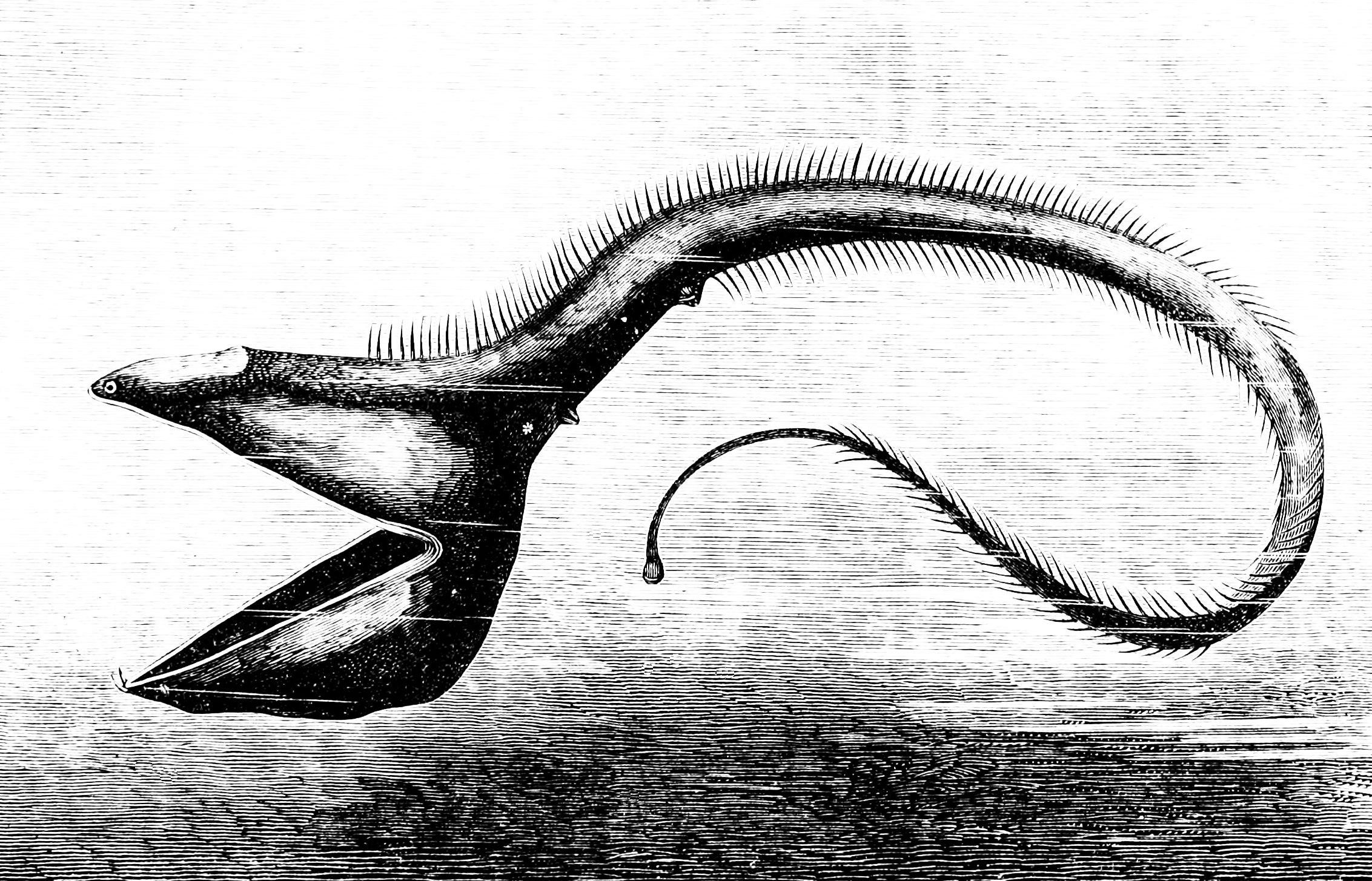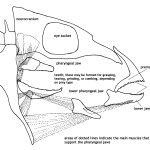Here’s a mystery: below 8,400 meters there are no fish. There are other creatures: sea cucumbers, anemones, tiny worms, but no one has ever seen a fish. At 8,370 meters? There are fish. But not below 8,400 meters. At its deepest the ocean reaches roughly 11,000 meters, so there is plenty of space. And right below 8,400 meters it’s equally cold, equally dark, equally middle-of-no-where as it is right above 8,400 meters. But there is some magic line at 8,400 meters, below which fish apparently cannot go. No one understands why this line exists. Or if perhaps one day we’ll find a fish that can, in fact, cross it. But for now, scientists do have some ideas.
First, let’s talk about animals that can go below 8,400 meters. Lets talk about the deepest living animals on earth. The hadal amphipod is one of them:

This specimen was collected in the Sirena Deep [1]. At 10,500 meters, the Sirena Deep is one of the deepest places on Earth, resting a little under 100 miles south of Guam. This creature is one of the Sirena Deeps’ few residents. The yellow patches on either side of its head may be simple eyes [1]. The purpose of the red globe-like structures, along with much of the animal’s biology, remains a mystery. They are abundant below 8,400 meters.
Why do hadal amphipods thrive where fish do not? One person who has thought a lot about this is Dr. Paul Yancey, a deep-sea expert at Whitman College. The only real difference between 8,370 meters–the greatest depth at which fish have been found–and 8,400 meters, is pressure. Add an extra 30 meters, or about 100 feet, of seawater and you’ve added three extra atmosphere’s worth of pressure. Anyone who has tried to dive to the bottom of a pool and felt a squeeze in their ears can tell you that even a small change in pressure can make a big difference. The good news for fish is that water is not compressible like the air inside our ears. I had always assumed that, as long as an animal is made mostly of water, without any trapped gas to expand and compress, depth shouldn’t be an issue. But I was wrong, because pressure squeezes other things.
DNA. Proteins. Membranes. The very building materials of living animals are impacted by pressure. Proteins are particularly prone to problems. Proteins, which perform most of the work in our cells, including the pulling power of muscle, are crushed at high pressures. The muscles of shallow-water fish, for example, do not develop correctly under increased pressure [2]. And so deep sea animals must adapt.
Dr. Yancey has two hypotheses for how deep-sea fish cope with the massive pressure squeeze [3]. One possible adaptation is to counteract. You know that fishy smell from fish? That smell is from a special molecule known as trimethylamine oxide (TMAO). TMAO and regular old table salt have something in common. Have you ever spilled salt on a countertop in a humid climate, and come back to find little drops of moisture around the salt grains? Salt attracts water, and water-attracting molecules are called “osmolytes.” TMAO is also an osmolyte and it helps fish at shallow depths hold onto the water in their bodies, counteracting that other pesky osmolyte–salt–that they swim through all the time.
Dr. Yancey discovered that TMAO also helps cells function normally under pressure, by protecting proteins from crushing water molecules all around them. TMAO serves as a kind of protein stabilizer. Without TMAO, water molecules under pressure force their way into tiny protein folds, breaking apart protein structures and disrupting protein function. With TMAO, water molecules are not able to force themselves into these small cracks, and proteins keep working, even at great depths. Dr. Yancey suspects TMAO helps fish survive in the deep sea. But why the depth limit then? And what does this have to do with the mysterious 8,400 meter line?
“As fish go deeper, they need more TMAO,” Dr. Yancey explains [2]. More pressure may require more TMAO to keep cells working. But you can have too much of a good thing. Remember how TMAO is an osmolyte, a water-attracting molecule? It’s possible, Dr. Yancey hypothesizes, that at 8,400 meters fish “would need so much TMAO to counteract the pressure of the water that water would start flowing uncontrollably into their bodies” [2]. The same molecule that may protect against water pressure may ultimately cause water poisoning. In other words, the strange properties of TMAO may be responsible for the mysterious line in the deep sea, below which fish cannot go.
This hypothesis, however, is very hard to test. And Dr. Yancey concedes that “in another trench, maybe there is a fish that disproves my proposed depth limit.” If fish are there, they certainly are hard to find. And that’s good news for other denizens of the deep, like the hadal amphipod pictured above. These amphipods, and other animals below 8,400 meters, may have different adaptations to deal with such crushing pressures. This is especially fortunate for hadal amphipods, which are a favorite snack of fish above 8,400 meters. For now, the amphipods’ mysterious ability to survive in the deepest deep sea has afforded them the luxury of a fish-free freezing black abyss all their own.
https://www.youtube.com/watch?v=cBxsm5T2yN8
(The video above is of a very deep fish, taken at 8,143 meters, and is a contender for the deepest fish, along with a tongue-twister of a fish: Bassogigas profundissimus, collected with a net from possibly as deep as 8,370 meters in the Puerto Rico Trench [5].)
References
[1] Photo: A hadal amphipod from 10,500 m in the Sirena Deep http://www.schmidtocean.org/file/show/3498
[2] Life Under Pressure – 100 Elephants on Your Head. Schmidt Ocean Institute expedition update. By Dr. Paul Yancey. http://schmidtocean.org/story/show/3236
[3] PH Yancey, ME Gerringer, JC Drazen, AA Rowden & A Jamieson (2014) Marine fish may be biochemically constrained from inhabiting the deepest ocean depths. PNAS. 4461–4465, doi: 10.1073/pnas.1322003111. http://www.pnas.org/content/111/12/4461.full
[4] The Deepest Living Animals. Schmidt Ocean Institute expedition update. By Dr. Paul Yancey. http://www.schmidtocean.org/story/show/3494/
[5] Staiger JC. 1972. Bassogigas profundissimus (Pisces; Brotulidae) from the Puerto Rico Trench. Bulletin of Marine Science22: 26–33. (PDF)







Very informative, thank you.
Such an ethereal looking fish in the video, like a deep-sea angel. Hopefully no harm came to him/her.
I am not fully convince by this explanation about pressure variation… It seems too simple:
When you dive 20 meters, yes, you really have to adjust pressure in your ears, if you do not, it may be really painful.
The reason for this is because the air in your ear is compressed by the pressure of water, and 20 meters bellow, it has increased 3 times (+200%).
If you where able to dive (without a submarine) at 8370 meters and decided to dive 30 meters more, you wouldn’t have to worry about your ears (even if you’re not already dead, I mean), because the variation would be about + 0.3% (if you where to proceed to the challenger deep, the increase would be about 30 % (from 8370 m), again, the variation isn’t that impressive compared to the first 40 meters or so).
Beside, proteins and gas-filled organs probably don’t react the same way to pressure… But how can we be sure that proteins are the limiting factor? Cell membranes are also adapted to the intense pressure of deep-water environment – I don’t have the paper at hand – but I read that they have a composition that helps them remain flexible and perform their function correctly, so perhaps the limitation is here… Or elsewhere… Who knows? There are undoubtedly thresholds, but where and why, that is the question.
Anyway, it is really interesting to know there aren’t fishes bellow 8400 meters, I didn’t know that. I’d be interested to know the distribution limits of other groups also! Deep water environments are so alien to us… Each time I learn about it is almost like I heard news from another planet: it’s magic!
Isn’t it just incredible? For other groups, Paul Yancey mentioned that there are no decapods below ~8000 meters. The ocean below ~8000 is a very strange place indeed…
I agree with you–there are a lot of factors that likely impact depth distribution. Cell membranes also came to mind for me, too. I guess the big challenge is how to test these things. You’re right that the difference in pressure is so minor between these lines that intuitively it seems unimportant (I hadn’t articulated it mathematically–good addition). My guess is that fish probably decrease in abundance gradually, with 8400 meters being at the end of that decline. From the little work I’ve done with mid-water ROVs, my impression is that biomass in general slowly drops off with depth. The abyss at 3600 meters is pretty empty compared to the 1000-2000 meter range.
Truthfully, I really haven’t thought much about pressure, and that’s why I find it so fascinating. I’ve worked with deep-sea jellies, and our biggest concerns were temperature and light. As long as we kept them cold and dark, we assumed they would be more or less OK, at least for the short time we worked with them. I’m now wondering how the change in pressure impacted their biology.
More generally, how do adaptations to pressure impact where animals can and cannot live? For example, we only find some jellies in a very narrow depth range. Say, 2500-3000 meters. Not above, not below. Why? Are they tracking a particular water mass? Are they intentionally aggregating? Or are they most well suited to that depth range? I really don’t know…but it’s fun to think about. Nature is amazing.
I guess that you are right, abundance is probably decreasing slowly before 8400 meters.
Obviously we need more ROVs, so that we can sample and have diversity curves plotted against temperature, salinity and depth.
Concerning pressure, I think it is to address this concern that the Abyssbox was developped. I think a fish and a shrimp were kept alive in it… Apparently they would not have survived long without a high pressure. The problem is that the Abyssbox is a very small container, 16 L according to wikipedia, so it seem a little small for many deep-sea species.
Nice review. I’ve long thought that pressure information was a good hypothesis to explain how many deep-sea animals seem to maintain species-specific depth ranges, without having any other apparent cues available. Some bathypelagic nemerteans feed exclusively on copepods, with gut cells becoming packed with and storing orange oil droplets derived from the copepods. When the worms are brought to the surface alive, via thermally protected cod end, they live up to days but immediately start exuding oil droplets through their entire epidermal surface. I’ve thought this is a result of the oil droplets expanding, rupturing the gut’s storage cells and even making microscopic holes in the epidermis. If those lipids expand that much, I figured certain membrane lipids can act as transducers to provide pressure information.
“I figured certain membrane lipids can act as transducers to provide pressure information.” Wow, I’ve never heard of anything like that, but I’m really digging the idea. If fundamental features of an organism’s biology changes with pressure, having a way to sense and interpret subtle pressure changes could be pretty useful. Specialized organs? Cells? Organelles? Molecules? Wow…that’s really interesting…
A bit like a reverse treeline:
http://www.nature.com/scitable/content/ne0000/ne0000/ne0000/ne0000/15899424/f2_berdanier.jpg
At some point the conditions are absolutely no longer suitable but there is a gradient along the way.
Fascinating fish… It’s basically a swimming head/stomach with attached fins for locomotion. Just enough tunk & tail to hold the spinal cord and minimal musculature to generate undulatory waves.
is it possible that some type of fish will eventually get below the 8400m line, but those fish haven’t evolved yet? i don’t know if this is true, but i would think that fish evolved at initially a shallower depths and have been “working their down” ever since.
^ “working their way down”, that is.
I am no fish evolution specialist.
But I am not sure we can assess with confidence that fishes have a trend to live deeper. Preservation of fossil fishes requires good conditions that do not occur everywhere.
And, I don’t think that very deep water fauna are that frequent.
Also, yes, it is possible that fishes will evolve to live deeper, but in general evolution is difficult to predict and subject to contingency… For instance, after over 500 MA, echinoderms are still stubbornly restricted to salt waters.
Too bad for the Ancelade sub-ice ocean… won’t find many salmon there… nor moon fish surprinsingly
So fascinating here. Do you happen to know of any other educational resources related to these extreme-deep-sea environments? Fish or not, whatever is down there is so interesting.
These hadal amphipods – what do they eat? What does whatever they eat, eat? How low can they go before the pressure is too much for them?
I wonder if there is ever a point where the nature of DNA starts to change to resist pressure better. Perhaps there are mutations with stronger or bigger clusters of proteins that are more resistant to pressure. It could probably tell us a lot of useful things, too, as I think many extremophiles can, but really it’s just fascinating in its own right.
The deepest ocean is also very cold. Fish fight cold with glycol, which could become very toxic under the pressures we are talking about. Just a thought,
I understand the basics of the biology and physics here, but I’d hesitate before determining the deep to be “fish-free.” Evolution is, in action if not in intent, unbelievably clever about fine-tuning life to exist where it should not. Ask the folks who put tardigrades on the OUTSIDE of the International Space Station and recovered them alive.